Showing 625–636 of 816 resultsSorted by popularity
-
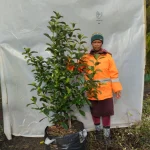
Viburnum Sinensis 70lt
R2,450.00Add to cartViburnum Sinensis 70lt
Common Name: Sweet ViburnumFull Sun
Semi Shade
Low Watering
Wind tolerant
Excellent Hedging plantFull Sun
Semi Shade
Low Watering
Wind tolerant
Excellent Hedging plantViburnum sinensis, commonly known as Sweet Viburnum, is a deciduous shrub found in South Africa. It belongs to the Adoxaceae family and is a favoured ornamental plant due to its beautiful flowers and attractive foliage.
Sweet Viburnum is renowned for its large, striking flower clusters that resemble fluffy, round snowballs, earning it its common name. These flower clusters can reach sizes of 15 to 20cm in diameter and are typically creamy white in colour. They grace the garden with their presence in late spring to early summer, creating a stunning visual display.
The leaves of Viburnum sinensis are oval-shaped, glossy, and dark green. During autumn, they often transition to hues of red or purple, adding to the shrub’s visual appeal. This particular shrub can grow to heights of 6 meters and has a rounded or slightly spreading growth habit.
Viburnum Sinensis thrives in areas with full sun to partial shade in South Africa. It prefers well-draining soil and exhibits tolerance to various soil types, including clay, loam, or sandy soil. Regular watering is necessary during the establishment phase, but once established, it can withstand some drought conditions.
Pruning is typically carried out after the flowering period to maintain the desired shape and remove any dead or damaged branches. This practice can also encourage better flower production for the following year.
Viburnum sinensis is generally a hardy and low-maintenance shrub in South Africa. It exhibits relative resistance to pests and diseases. However, it is recommended to monitor the plant for any signs of issues and take appropriate action if necessary.
Sweet Viburnum is often utilised as a focal point in landscaping, as a hedge, or as part of mixed shrub borders in South Africa. Its large, eye-catching flowers make it a standout in the garden and attract bees and butterflies. Additionally, the flowers can be cut and used in floral arrangements to bring their beauty indoors.
Overall, Viburnum sinensis, is a delightful shrub appreciated for its stunning flower clusters and attractive foliage in South African gardens. Its resilience, low maintenance requirements, and versatility in various garden settings make it a popular choice for adding beauty and charm to outdoor spaces.
-
Sale!

Ficus rubiginosa 100lt (Rusty Fig)
Original price was: R3,495.00.R1,895.00Current price is: R1,895.00.Add to cartFicus rubiginosa 100lt (Rusty Fig)
Common Name: Rusty Fig, Port JacksonFull Sun
Semi Shade
Light Watering -
Sale!

Tecomaria Capensis Salmon 10lt
Original price was: R225.00.R150.00Current price is: R150.00.Add to cartTecomaria Capensis Salmon 10lt
Common Name: Cape Honey SuckleFull Sun
Semi Shade
Low Watering
Indigenous
Evergreen
Creeping/Bush
Fast Growing -

Ekebergia Capensis 10lt
R240.00Add to cartEkebergia Capensis 10lt
Common Names: Cape Ash, Dogplum, EssenhoutFull Sun
Low Watering
Indigenous
Evergreen
Drought Tolerant When EstablishedEkebergia capensis, commonly known as the Cape ash or African ash, is a tree species native to South Africa.
Habitat: Ekebergia capensis is found in various parts of South Africa, including the Cape Peninsula, Eastern Cape, KwaZulu-Natal, Mpumalanga, and Limpopo. It typically grows in woodland and forest habitats, often near rivers or in moist areas.
Description: It is a medium-sized to large deciduous tree that can reach heights of up to 20 meters. The tree has a dense, rounded crown and a straight trunk. The bark is greyish-brown and becomes rough and fissured as the tree matures. The leaves are compound, with leaflets arranged in pairs, and they are shiny dark green in colour.
Flowers and Fruits: Ekebergia capensis produces small, creamy-white flowers in dense clusters. The flowers are fragrant and attract bees and other insects for pollination. After pollination, the tree develops small, round fruits that turn purple when ripe. The fruit contains a single seed and is edible, but not commonly consumed by humans.
Uses: Ekebergia capensis has several uses in traditional medicine and cultural practices. Various parts of the tree, such as the bark, leaves, and roots, are used for their medicinal properties. The wood is durable and used in construction, furniture making, and for fuel. The tree also has some cultural significance and is often planted as an ornamental tree in gardens and public spaces.
Conservation status: Ekebergia capensis is not currently listed as a threatened species. However, like many tree species, it can face threats from habitat loss, deforestation, and invasive species. Conservation efforts are important to preserve the natural habitats where this tree species occurs.
-
Sale!
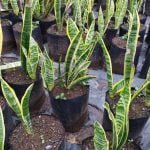
Sansevieria Trifasciata ‘Laurentii’ 10lt
Original price was: R325.00.R210.00Current price is: R210.00.Add to cartSansevieria Trifasciata ‘Laurentii’ 10lt
Common Name: Snake Plant, Mother In Laws TongueFull Sun
Semi Shade
Low Watering
Evergreenansevieria trifasciata ‘Laurentii’ is a popular cultivar of the Sansevieria trifasciata species, commonly known as Snake Plant or Mother-in-Law’s Tongue. The ‘Laurentii’ variety is characterized by its tall, upright leaves with bold yellow margins that contrast with the dark green center.
The Snake Plant is a hardy and low-maintenance plant that is widely appreciated for its air-purifying qualities and ability to tolerate a wide range of growing conditions. It is native to West Africa but has become a popular houseplant worldwide.
The ‘Laurentii’ cultivar, with its distinctive yellow-edged leaves, adds a touch of elegance and visual interest to any indoor space. The leaves grow in an erect manner, reaching heights of up to several feet, and have a sword-like shape. The variegation of yellow and green creates a striking and eye-catching display.
As a low-maintenance plant, the Snake Plant is known for its resilience and ability to tolerate neglect. It thrives in various lighting conditions, from bright indirect light to low light, making it suitable for different areas of the home or office. However, it tends to grow more vigorously and maintain its variegation better in brighter light.
In terms of watering, Snake Plants are drought-tolerant and prefer to dry out between waterings. It’s important to avoid overwatering, as they are prone to root rot in overly wet soil. It is generally better to underwater than to overwater these plants. Allow the top inch or so of the soil to dry out before watering again.
Snake Plants are typically potted in well-draining soil to prevent waterlogging. Repotting is usually done when the plant has outgrown its current container or to refresh the soil every few years.
In addition to its attractive appearance, the Snake Plant is known for its air-purifying abilities. It efficiently removes toxins such as formaldehyde, benzene, and xylene from the air, making it a great choice for improving indoor air quality.
Overall, the Sansevieria trifasciata ‘Laurentii’ is a stunning cultivar of the Snake Plant that adds a touch of sophistication to any indoor setting. Its yellow-edged leaves, combined with its easy-care nature, make it a popular choice among plant enthusiasts and beginners alike.
-
Sale!
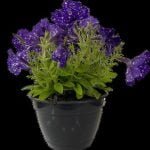
Petunia Perennial Assorted 21cm H/B
Original price was: R195.00.R149.99Current price is: R149.99.Add to cartPetunia Perennial Assorted 21cm Hanging Basket
Petunias are commonly grown as annuals, but there are also perennial varieties available. While the majority of petunias are annuals, meaning they complete their life cycle in one growing season, perennial petunias can come back year after year with proper care. However, it’s important to note that perennial petunias are not as common or widely available as the annual varieties.
Perennial petunias belong to the species Petunia axillaris and Petunia integrifolia. They are often referred to as “wild petunias” or “perennial petunias.” Here are some key characteristics of perennial petunias:
Growth habit: Perennial petunias tend to have a more compact and upright growth habit compared to the trailing or spreading habit of many annual petunias. They form mounds of foliage and produce an abundance of flowers.
Flowers: The flowers of perennial petunias are typically smaller than those of their annual counterparts. They come in various colours, including shades of pink, purple, and white. The flowers have a trumpet-like shape similar to the annual petunias.
Perennial nature: Perennial petunias are capable of returning year after year in suitable growing conditions. They can be treated as herbaceous perennials, dying back to the ground in winter and regrowing from the roots in spring.
Care and maintenance: Perennial petunias require similar care to other garden perennials. They prefer well-draining soil and full sun to partial shade. Regular watering and mulching can help maintain moisture levels in the soil. Deadheading spent flowers can encourage continuous blooming. In colder regions, providing winter protection such as mulching or covering the plants can increase their chances of survival.
Propagation: Perennial petunias can be propagated through division or by taking stem cuttings. Division involves separating the plant into smaller sections and replanting them, while stem cuttings involve rooting a stem segment in a suitable growing medium.
It’s worth mentioning that many gardeners prefer to grow annual petunias due to their larger flower size, more extensive colour range, and abundant blooming throughout the growing season.
-
Sale!
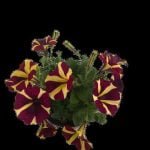
Petunia Perennial Assorted 14cm Pot
Original price was: R110.00.R89.99Current price is: R89.99.Add to cartPetunia Perennial Assorted 14cm Pot
Petunias are commonly grown as annuals, but there are also perennial varieties available. While the majority of petunias are annuals, meaning they complete their life cycle in one growing season, perennial petunias can come back year after year with proper care. However, it’s important to note that perennial petunias are not as common or widely available as the annual varieties.
Perennial petunias belong to the species Petunia axillaris and Petunia integrifolia. They are often referred to as “wild petunias” or “perennial petunias.” Here are some key characteristics of perennial petunias:
Growth habit: Perennial petunias tend to have a more compact and upright growth habit compared to the trailing or spreading habit of many annual petunias. They form mounds of foliage and produce an abundance of flowers.
Flowers: The flowers of perennial petunias are typically smaller than those of their annual counterparts. They come in various colours, including shades of pink, purple, and white. The flowers have a trumpet-like shape similar to the annual petunias.
Perennial nature: Perennial petunias are capable of returning year after year in suitable growing conditions. They can be treated as herbaceous perennials, dying back to the ground in winter and regrowing from the roots in spring.
Care and maintenance: Perennial petunias require similar care to other garden perennials. They prefer well-draining soil and full sun to partial shade. Regular watering and mulching can help maintain moisture levels in the soil. Deadheading spent flowers can encourage continuous blooming. In colder regions, providing winter protection such as mulching or covering the plants can increase their chances of survival.
Propagation: Perennial petunias can be propagated through division or by taking stem cuttings. Division involves separating the plant into smaller sections and replanting them, while stem cuttings involve rooting a stem segment in a suitable growing medium.
It’s worth mentioning that many gardeners prefer to grow annual petunias due to their larger flower size, more extensive colour range, and abundant blooming throughout the growing season.
-
Sale!
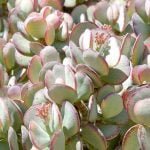
Crassula Ovata Arborescens 20lt
Original price was: R550.00.R425.00Current price is: R425.00.Add to cartCrassula Ovata Arborescens 20lt
Common Name: Silver Jade PlantFull Sun
Semi Shade
Low Watering
Evergreen
Drought Tolerant -
Sale!
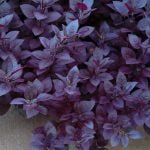
Altenanthera Little Ruby 17cm Pot
Original price was: R125.00.R75.00Current price is: R75.00.Add to cartAltenanthera Little Ruby 17cm Pot
-

Viburnum Tinus Lucidum 17cm Pot
R125.00Add to cartViburnum Tinus Lucidum 17cm Pot
Full Sun
Wind Tolerant
Low Watering
Evergreen -

Syzygium Paniculatum 17cm Pot
R125.00Add to cartSyzygium Paniculatum 17cm Pot
Common Name: Australian Brush-cherry, EugeniaFull Sun
Semi Shade
Indigenous
Drought Resistant
Evergreen
Medium Watering
Wind Tolerant
Hedging Tree -

Hibiscus White 23cm Pot
R150.00Add to cartHibiscus White 23cm Pot
Full Sun
Semi Shade
Low Watering
Evergreen
